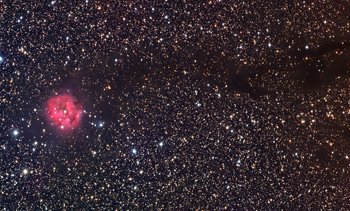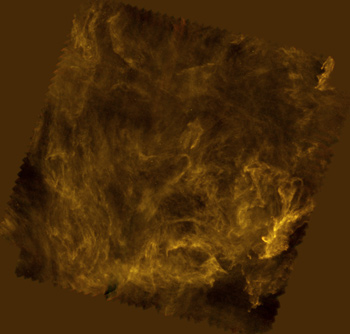At the end of May, 2010, the European Space Agency’s orbiting Herschel telescope was pointed toward a dark cloud in space over 2500 light years away. What it saw may solve a bit of a scientific mystery… and is also truly beautiful:
[Click to ennebulanate.]
This object is called IC5146, and consists of the Cocoon nebula on the left, and two long streamers of gas extending to the right. Herschel is very sensitive to cold dust in the very far infrared; in this image blue shows gas and dust emitting at a wavelength of 70 microns (the reddest color the human eye can see is roughly 0.7 microns), green is 250 microns, and red 500 microns – that’s over 700 times the longest wavelength light the eye can detect.
 The Cocoon nebula is a well-known gas cloud being lit up by a massive, hot star in its center. In the visible light image inset here – grab the stunning high-res version to compare to the Herschel shot – the dust is dark, since it absorbs the kind of light we see. Also, stars are pretty faint at these extreme infrared wavelengths, so they don’t interfere with the observations of the gas and dust. That’s why observatories like Herschel are so important: they allow us to investigate objects that might be invisible to other telescopes.
The Cocoon nebula is a well-known gas cloud being lit up by a massive, hot star in its center. In the visible light image inset here – grab the stunning high-res version to compare to the Herschel shot – the dust is dark, since it absorbs the kind of light we see. Also, stars are pretty faint at these extreme infrared wavelengths, so they don’t interfere with the observations of the gas and dust. That’s why observatories like Herschel are so important: they allow us to investigate objects that might be invisible to other telescopes.
As you can see in the Herschel image, the entire region is interlaced with long, thin filaments of dust. This dust is cold: much of it is only about 15° Celsius above absolute zero, or -430°F! What’s so very interesting is that the filaments, no matter what length they are (and as seen in other parts of the sky by Herschel as well), seem to have about the same width of roughly 0.3 light years across. That argues very strongly that these filaments are formed from turbulence in the dust, probably caused by exploding stars roiling up the matter between stars. That width is just about what you’d expect as shock waves from exploding stars slam into each other, interact, and become turbulent.
Looking at other filaments like these in other parts of the sky, astronomers also found about 100 dense knots of dust that are forming into stars in the filaments. This shows clearly that these filaments are the sites of star birth, something that was unclear before these Herschel observations. Not all filaments form stars, but the fact that some do will help astronomers understand the fiercely complicated mechanics of star formation.
 These filaments are all over the sky; the image here from Herschel is actually of a region on the sky near the star Polaris (click to get a much bigger, very cool picture), which I would’ve thought would be nearly empty of dust. But clearly there are filaments galore there, and again they show that same characteristic width of 0.3 light years. Apparently supernovae have been going off all over the galaxy for quite some time, their expanding gas stirring up the ethereally thin material of interstellar space. In fact, these filaments are considered by astronomers to be dense, but the air in Earth’s atmosphere is hundreds of trillions times denser!
These filaments are all over the sky; the image here from Herschel is actually of a region on the sky near the star Polaris (click to get a much bigger, very cool picture), which I would’ve thought would be nearly empty of dust. But clearly there are filaments galore there, and again they show that same characteristic width of 0.3 light years. Apparently supernovae have been going off all over the galaxy for quite some time, their expanding gas stirring up the ethereally thin material of interstellar space. In fact, these filaments are considered by astronomers to be dense, but the air in Earth’s atmosphere is hundreds of trillions times denser!
In astronomy, thin means thin. But over trillions of kilometers, even material that rarefied can eventually condense from gravity and form mighty stars.
The Universe is a lesson in superlatives, from thin to dense, from huge to huger, from chillingly cold to searingly hot. And, as usual, the beauty of the images themselves is rivaled by the beauty of the science and knowledge we derive from them.
Image credits: Herschel IC5146: ESA/Herschel/SPIRE/PACS/D. Arzoumanian (CEA Saclay) for the “Gould Belt survey” Key Programme Consortium; Herschel Polaris region: ESA/Herschel/SPIRE/Ph. André (CEA Saclay) for the Gould Belt survey Key Programme Consortium and A. Abergel (IAS Orsay) for the Evolution of Interstellar Dust Key Programme Consortium; Optical image: Adam Block/NOAO/AURA/NSF
Related posts:
- The cold arms and hot, hot heart of the fuzzy maiden
- A hole in space… no really, an actual hole!
- Chaos! Turbulence! Blowouts! Herschel!
- Herschel eyes the infrared Southern Cross
- Herschel opens its eye